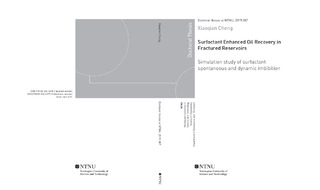| dc.description.abstract | Water flooding has poor performance in fractured reservoirs with mixed- or oil-wet wettability. Surfactant could be used to improve oil recovery by changing wettability to more water-wet or reducing water/oil interfacial tension (IFT). A surfactant spontaneous imbibition model is established using experimental data from literature, and a surfactant dynamic imbibition model is established based on the spontaneous imbibition model. Surfactant mechanisms, matrix properties, surfactant properties, upscaling methods, and surfactant flooding in fractured matrix are studied by simulations with Eclipse 2014.1.
Wettability alteration to more water-wet could enhance oil recovery rate and ultimate oil recovery. If water/oil IFT is reduced by surfactant, ultimate oil recovery is increased when capillary number is larger than the critical capillary number (i.e. 10-8), but oil recovery rate is decreasing with the decrease of IFT. In general, for mixed- or oil-wet systems, wettability alteration is more efficient than IFT reduction to improve oil recovery.
The most frequently used existing upscaling methods are mainly for surfactant imbibition dominated by gravity or capillary pressure. The existing upscaling methods, which consider both wettability alteration and IFT reduction or both gravity and capillary pressure, are not widely used. In this thesis, new upscaling methods are introduced, which include wettability alteration, IFT reduction, gravity and capillary pressure. Therefore, the proposed upscaling methods can be used for surfactant imbibition dominated by gravity or capillary pressure or both gravity and capillary pressure. The proposed upscaling methods are verified by simulation results of surfactant spontaneous imbibition under three different conditions according to the bound number: NB ≥ 1, which is for the surfactant imbibition dominated by gravity; 0.1 < NB <1, which is for the surfactant imbibition dominated by both gravity and capillary pressure; NB ≤ 0.1, which is for the surfactant imbibition dominated by capillary pressure.
Oil recovery rate and ultimate oil recovery are increasing with the increase of matrix permeability, but surfactant enhanced oil recovery (EOR) is reducing and then increasing with the increase of matrix permeability. The turning point of the trend occurs around the bound number of 1. Matrix porosity has little effect on surfactant imbibition, especially when wettability is changed to strongly water-wet by surfactant. Oil recovery rate is decreasing with the increase of matrix block size both for brine and surfactant imbibition. The increase of matrix block size leads to an increase of ultimate oil recovery, and the increase degree is smaller when wettability is more water-wet. The proposed upscaling methods are tested and modified based on the simulation results of the effects of matrix permeability, matrix porosity, and matrix block size on surfactant spontaneous imbibition.
The simulation study of the effects of surfactant properties on surfactant spontaneous imbibition shows that viscosity of surfactant solution almost has no effect on surfactant spontaneous imbibition. Surfactant concentration can increase ultimate oil recovery when concentration is lower than critical micelle concentration (CMC). But when concentration is above CMC, ultimate oil recovery does not change with the increase of concentration. Surfactant adsorption could reduce oil recovery rate but has no effect on ultimate oil recovery. Surfactant diffusion could expedite surfactant imbibition into matrix, while it does not affect ultimate oil recovery. Upscaling methods that include the effect of surfactant concentration and adsorption are proposed.
Surfactant injection rate into a fractured matrix could significantly accelerate oil recovery until injection rate reaches 0.0005 PV/h. Using the injection rate of 0.0005 PV/h, the oil recovery after injecting 1 PV surfactant solution is 68% original oil in place (OOIP), which is about 85% of ultimate oil recovery. Surfactant diffusion is very important for surfactant dynamic imbibition since surfactant diffusion is very efficient for surfactant movement into matrix when capillary pressure is very small or negative. The effect of injection rate on surfactant dynamic imbibition is larger when surfactant diffusion is slower, or fracture porosity is smaller. The required injection volume of surfactant solution to obtain ultimate oil recovery is increasing with the increase of pre-water flooding volume. Therefore, surfactant should be applied before water flooding. The surfactant with low diffusion coefficient should not be used in tertiary oil recovery stage. Oil recovery rate is slower, and the required injection volume of surfactant solution is increased when the injected surfactant concentration is smaller. In addition, surfactant solution with lower concentration has lower efficiency because less surfactant could be imbibed into matrix. | |
